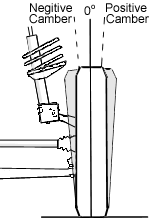Getting Lined Up: Alignment Basics
We went into quite some detail about camber and caster in a previous installment of Tech Talk, but many people still ask us basic questions about a car's alignment in general. So in this installment we will try and tackle all of the basics of a standard four wheel alignment, what the various terms mean, and what "set-up" is best for what application.
Aligning a car refers to adjusting the various angles each wheel has in relation to the ground, the chassis and each other. Contrary to intuition, the wheels of most cars do not stand straight up, nor are they parallel to each other. There are specific reasons for the way the wheels are positioned and a proper alignment takes into consideration the cause and affect of each position.
Three of the most basic adjustnments made are camber, castor and toe.
Camber is the angle-- from vertical-- that a tire's centerline makes when viewed from the front. In other words, when you look at a tire from the front of your car, the degree to which the tire is angled inward or outward at the top is the camber angle. If the wheel is angled in at the top (most common on modern cars) it has negative camber. If it is angled out at the top, it has positive camber (many old race cars are set-up with positive camber).

Castor is the angle-- again from vertical-- that the pivot point makes when veiwed from the side. Draw an imaginary line that goes through the center of the wheel, the center of the upper and lower ball joints or through the center of the strut assembly. The degree to which this line is angled is the castor angle. If the top is angled toward the back, castor is positive (most common on modern cars). Vice versa it is considered negative (shopping cart wheels or "castors" are always negative).

Toe is the angle the wheels make from the centerline of the car, as seen from the top. In other words, if the wheels are pointed in at the front, or the measured distance between the fronts of the wheels is less than the rears of the wheels, they are toe in (typical on most modern cars). If the wheels are splayed out at the front, they are toe out. If the wheel centerlines as seen from above are parallel, they have zero toe.

The geometery of various suspension designs changes what the preferred camber, castor and toe settings are. The geometry also changes the various settings throughout its range of movement. So one has to consider not only the steady state, but also what happens when weight is transferred when the car is put into a corner, drives over a bump, or accelerates. As you can see, things can become very complicated, very quickly.
For a car driven primarily on the street, we will adjust the settings (those that are adjustable) within manufacturers guidelines. If the car will be driven on the track, we will set the car up a little differently. Typically-- and this is really dependent upon the suspension geometry-- we will dial in more negative camber, maximum positive castor, and some toe out in the front.